Content
- 1 Why do children need vitamin D3
- 2 What products contain
- 3 Symptoms of vitamin D3 deficiency in children
- 4 Daily dose of vitamin D3 for children
- 5 Is it necessary to give the child vitamin D3
- 6 Up to what age children are given vitamin D3
- 7 Is it possible to give a child vitamin D in the summer
- 8 The best preparations with vitamin D for children
- 9 Which vitamin D is better: oil or water
- 10 How to properly give vitamin D to a child
- 11 When is it better to take vitamin D for children
- 12 Side effects of vitamin D in children
- 13 Symptoms of an overdose of vitamin D3 in children
- 14 Child allergy to vitamin D3
- 15 Conclusion
- 16 Reviews of vitamin D for children
The growing body of a child needs additional substances that ensure full growth and development. Vitamin D for children promotes skeletal formation and supports the central nervous system. This substance is important for baby's growth and tissue renewal.
Why do children need vitamin D3
Vitamin D is a vital metabolically active compound that is either synthesized by the body using UVB light or absorbed through the digestive system from certain foods. Its role is to facilitate the absorption of calcium from the intestines and maintain calcium homeostasis.
Those most at risk of vitamin D deficiency are children whose parents do not care about proper nutrition and / or are not exposed to enough UV light.
Also in this group are those who often use sunscreen.
Obesity, problems with malabsorption, taking anticonvulsants, and dark skin pigmentation are additional risk factors. Malabsorption can result from conditions such as celiac disease, cystic fibrosis, inflammatory bowel disease, or kidney problems.
Vitamin D affects the formation of bones in a child. Severe deficiency can lead to rickets, when bones have insufficient levels of calcium and phosphorus, which causes them to soften and weaken before the epiphysial plates close. If left untreated with calcium supplements, rickets becomes osteomalacia after plate growth closes.
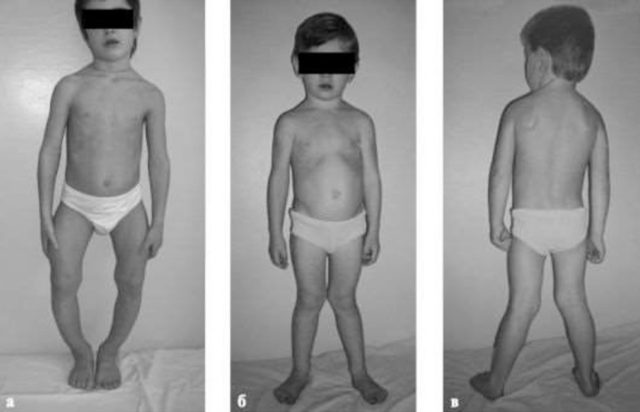
In adulthood, rickets is more difficult to cure. Therefore, the nutrition of the body with useful substances should be started from the birth of a child.
Vitamin D is important for the body of children. It promotes the absorption of phosphorus. The benefits of vitamin D3 for children:
- stimulates the synthesis of hormones;
- plays an important role in the growth of teeth;
- increases resistance to colds.
The child's sleep is improved with sufficient vitamin D. Adolescents are less likely to suffer from mental disorders.
What products contain
Less than 10% of the substance is absorbed from the diet. It is contained in the following products:
- tuna (85g = 154 IU);
- liver or beef (85 g = 42 IU);
- 1 large egg (41 IU per yolk)
- Fortified breakfast cereals (330 g = 40 IU)
- butter (up to 35 IU per 100 g);
- salmon (200-800 IU per 100 g);
- corn oil (9 IU in 100 g)
- herring (294-1676 IU per 100 g).
Dandelion, nettle, horsetail and alfalfa are found in large amounts. Some of the herbs are used to make jams and soups.
You can also get the substance from vegetable oils. It is good for children to cook food using olive, sunflower and other types.
Small amounts contain mushrooms, parsley, sour cream, brewer's yeast, potatoes, seeds and nuts. All milk is fortified with vitamin D. Breast milk contains 10-80 IU per liter, goat milk - 1.3 μg per 100 ml, cow milk - 1.5 μg.
Symptoms of vitamin D3 deficiency in children
Early signs of a lack of calciferol in newborns are manifested by excitability, light sleep, increased sweating during feeding. It is difficult for a growing child to sit, crawl, hair falls out and bald patches appear.

Hair loss begins with small bald patches that grow progressively if not treated promptly.
If a low level of vitamin D in a child is not noticed in a timely manner, the disease progresses to a softening of the skull. The process of the final formation of the skull is completed in the first 1.5 years of the baby. If vitamin D is poorly absorbed in a child, the fontanelle does not close, the skull becomes soft, this is manifested in dimples and dents on the head.
In babies with a lack of calciferol, there is a delay in mental and physical development. A decrease in vitamin D in a child leads to a noticeable general muscle weakness and tone.
Daily dose of vitamin D3 for children
The American Academy of Pediatrics recommends a daily supplement of 400 IU from birth to adolescence for all infants and adolescents, although this is well below the safe upper limit of intake.
In contrast, the Department of Health and Science in Russia recommends a daily intake of 400 IU of the compound during the first year of life, and then 600 IU at the age from 1 year to old age. The daily level of vitamin D in children should not exceed the following values:
- 1000 IU for infants up to 6 months;
- 1500 IU at the age of 6 months to 1 year;
- 2500 IU for babies up to 3 years old;
- 3000 IU at the age of 4-8 years;
- 4000 IU for children 9 years and older.
However, the Endocrine Society recommends more supplements for children at risk of vitamin D deficiency or low bone mass: 400-1000 IU for infants under 1 year old, 600-1000 IU for everyone else.

Part of the dissonance in these guidelines is which populations they target. While the health department's guidelines were written for healthy children and adolescents, the endocrine society specifically addresses those at risk of transplant recipients, those with chronic conditions that can cause malabsorption, and those taking anticonvulsants. or is receiving other treatments that threaten bone health. Among older children and adolescents, anorexia nervosa is also a risk factor for insufficient connection levels.
The norm of vitamin D in the child's blood is 20.50 ng / ml. These rates are the same for all ages and gender. If the blood level is less than 12 ng / ml, rickets develops.
Is it necessary to give the child vitamin D3
Babies under one year old are not recommended to be in direct sunlight, this is the difficulty of providing them with vitamin. There is no universal answer, since it depends on the conditions in which the baby is.
The application is indicated for persons who are in insufficiently sunny areas, if the baby cannot be taken out into the street for any reason.
Breastfed babies get enough substance from mother's milk, and formula-fed babies from formula milk.
Children's vitamin D3 does not have to be given to all babies. Reception of the remedy is justified for dark-skinned people (they have less substance in their skin).Be sure to prescribe vitamin D to children under one year or older with symptoms of rickets or lack of calciferol.
Up to what age children are given vitamin D3
In order to prevent rickets and other diseases, it is necessary to give vitamin DZ up to 2-3 years. It is canceled for the summer period if there are no signs of a shortage.
Is it possible to give a child vitamin D in the summer
Cholecalciferol is independently synthesized in the skin under the influence of ultraviolet radiation. If there are clear signs of a lack of cholecalciferol, rickets, or it rarely happens in the sun, prevention is not prohibited.
The best preparations with vitamin D for children
According to a 2014 study, more than 66% are deficient in vitamin D. There are 5 best drugs, according to reviews and recommendations from doctors.
Aquadetrim
1 ml of solution contains 15000 IU of vitamin D. The aqueous solution is well absorbed in the small intestine. The absorption is fast.
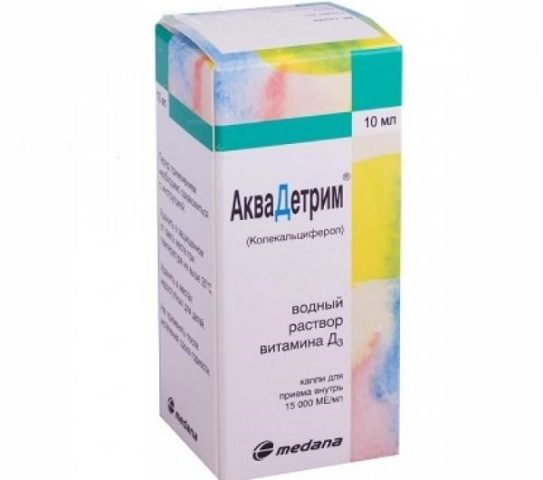
The drug is antirachitic. The action is aimed at the metabolism of calcium and phosphate. The use is prohibited for hypervitaminosis with this substance, hepatic and renal failure, sarcidosis.
Materna, Tiptipot Vitamin D
The medicine is optimized for babies from birth. The drug promotes the absorption of calcium in the blood and strengthens bones.
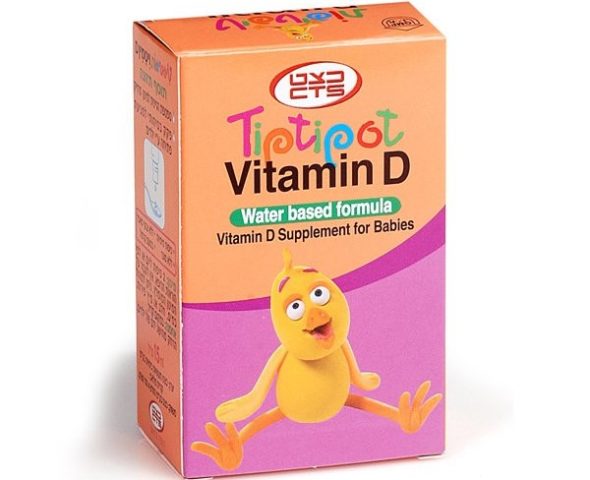
There is no alcohol in the composition, it is well tolerated. The disadvantage is the relatively high price, not always available.
Green peach
Contains no chemicals, preservatives or artificial colors. The water-based product is completely natural. Equipped with a convenient dispenser.
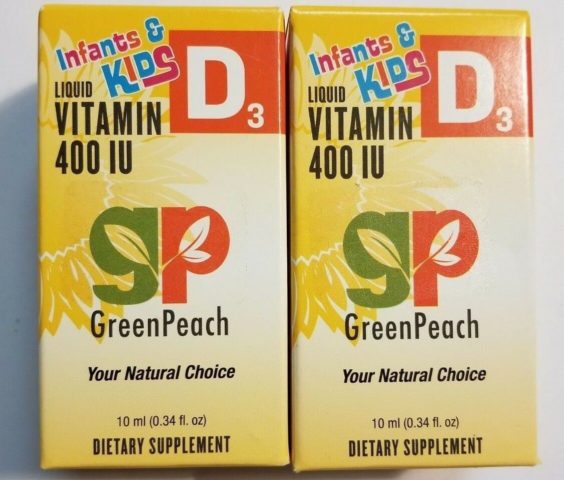
Take 4 drops daily as directed. The food supplement does not contain sugar, therefore it is allowed for use by children from 1 year old.
Calcium-D3 Nycomed Forte
The drug is sold in pill form. Designed for oral use in adolescents and adults.
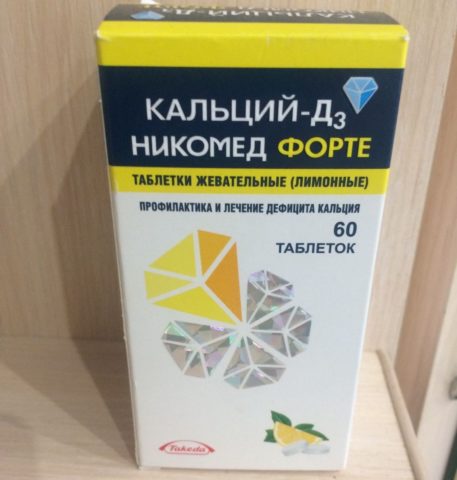
It is well tolerated. Rarely causes nausea, polyuria, and epigastric pain.
California Gold Nutrition, Baby Vitamin D3 Drops (400 IU)
Vitamin D3 is used for the prevention and treatment of rickets. Assigned to adolescents for the treatment of osteoporosis. It is allowed to give to children from birth, add to milk, juice and other food products.
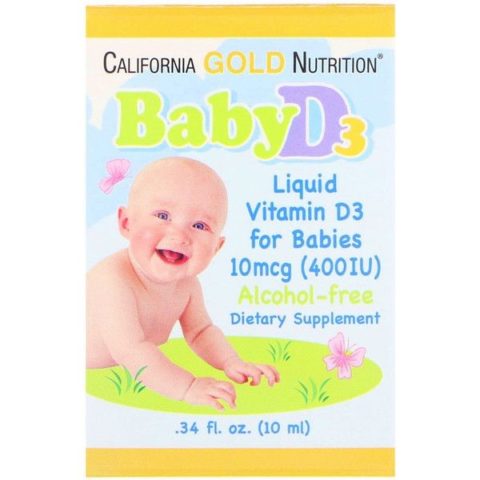
Shake the bottle before use. They give the medicine 10 mcg until the child starts drinking at least 1 liter of water per day.
Which vitamin D is better: oil or water
Vitamin D3 for children on a water basis has a reduced biological activity. It is prescribed for babies with diseases of the pancreas and intestines, when they are not able to fully absorb the fats from food. The water-based product contains preservatives and a stabilizer.
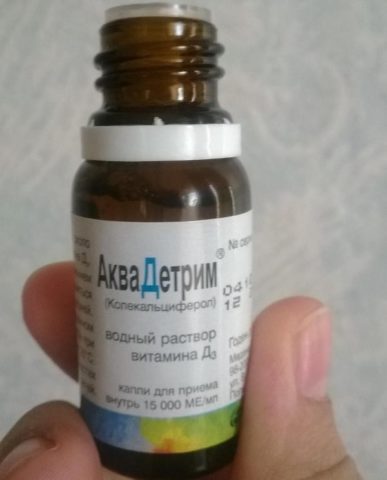
The oily form contains only oil and the compound itself. The first is a natural preservative.
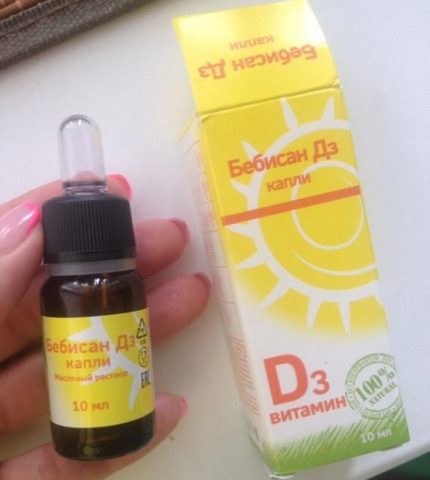
Based on this, it follows that an oil preparation is preferable if there is no allergic reaction.
How to properly give vitamin D to a child
Babies are better off if they receive nutrients in breast milk. If the baby is artificially fed, then the drug is prescribed in drops.
Rules for taking vitamin D for children:
- Give 1 drop. This amount is sufficient for the normal development of children.The dosage is increased if there is a sign of rickets.
- Vitamin D3 drops for children are not given in pure form. Dilute in a mixture or spoon. It is impossible to drip directly into the mouth so that an overdose does not appear.
- It is recommended to introduce it at 4-5 weeks of life for full-term babies and at 14 days for premature babies.
If the baby is bottle-fed, the dosage of the medicine should be discussed with the pediatrician, since the substance is present in sufficient quantities in the formula.
When is it better to take vitamin D for children
It is correct to take vitamin D3 for children before lunch, in order to track the baby's reaction to the drug in the evening and, if necessary, immediately exclude its use. The substance in any form has increased allergenicity and is not suitable for all crumbs.
Side effects of vitamin D in children
The likelihood of adverse reactions depends on the dose and duration of therapy. They are worth knowing.
Side effects of vitamin D in children:
- poor appetite;
- xerostomia;
- myalgia and arthralgia;
- sleep disorder;
- mental problems;
- irritability;
- cardiac arrhythmia.
The excess is the result of the rapid overgrowth of the fontanelle. This leads to the premature closure of growth zones in the bones, which is fraught with impaired growth in growing babies.
Symptoms of an overdose of vitamin D3 in children
Signs will not appear if the child is given the drug in the amount prescribed by the doctor. Overdose is possible when using drops in a larger volume. Symptoms:
- long falling asleep;
- regurgitation or vomiting;
- enlargement of the liver and spleen;
- slow hair growth;
- hyperactivity;
- increased thirst;
- polyuria;
- diarrhea or constipation.
If the child receives vitamin D in excess, bones grow faster, and joints become stronger. This leads to curvature of the spine, frequent fractures and dislocations.
When taken in an increased amount, hypervitaminosis develops within 2-3 months. The disease is manifested by a sharp weight loss, up to anorexia, alternating constipation and diarrhea.
Child allergy to vitamin D3
A typical cause of an allergic reaction is the uncontrolled use of drugs with this substance. When vitamin D is in excess, it accumulates in the body and begins to have a toxic effect.
In rare cases, children develop individual intolerance. Genetically determined allergies are manifested by severe dehydration, hives, itchy skin, convulsions.

Initially, hives appear on the cheeks of children. Then red spots cover the rest of the body.
Allergies can be the cause of improperly selected vitamin D3. For example, with an expired date. Treatment of allergies in a child is based on a complete rejection of the use of a dubious medicine.
Conclusion
Vitamin DZ for children is necessary for the body to fight infections, form strong bones and proper muscle and heart function. In order for it to be beneficial, it is necessary to use the drug in the correct dosage.

